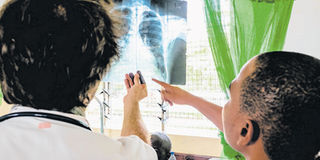Tackling TB by bridging rural, urban gaps

Medical staff examining the chest X-ray of a patient suspected to have TB.photo|file
What you need to know:
- For starters, tuberculosis (TB) is an airborne disease caused by a bacterium known as Mycobacterium tuberculosis (MTB) which is transmitted from person to person through infectious droplets when a potentially infectious patient sneezes or coughs.
The burden of TB is still huge globally, yet among certain people, the disease may also co-exist with other infections such as HIV, some parasitic worms and non-communicable diseases; especially diabetes. This means that such patients suffer ‘a double burden.’
For starters, tuberculosis (TB) is an airborne disease caused by a bacterium known as Mycobacterium tuberculosis (MTB) which is transmitted from person to person through infectious droplets when a potentially infectious patient sneezes or coughs.
At this point, governments and other stakeholders must not relent on the efforts to intervene strategically in dealing with the disease.
Currently, one thing that stands out in Tanzania is the need for public health interventions that are specific to the country’s settings; such as villages and urban areas.
If this is put in place and implemented successfully, it can help health workers improve on how to manage patients with TB and the diseases that co-exist with it (comorbidities).
As we speak, global TB reports of 2017 say there were about 1.6 million TB-related deaths whereas an estimated 10.4 million people fell ill due to the bacterial disease in 2016.
Tanzania is not spared. The prevalence of the disease varies considerably across regions and it’s higher among males, older persons, and those with lower socioeconomic status.
Yet still, more and more people are getting infected.
The risk of TB among HIV-positive patients is greater than among individuals who are HIV- negative. HIV increases the annual risk of TB among HIV positive individual and also accelerates progression of TB following exposure. Likewise, it has been documented that TB patients who have also been infected with parasitic worms (helminth), have poor treatment outcomes as compared to those TB patients who have no such co-infection.
When you read various studies, you can realize many disparities in people’s health-seeking behavior, knowledge of how the disease is transmitted, gender roles, socioeconomic status and disease burden.
The other, and one that we, at the Ifakara Health Institute (IHI) have been researching on, is on the rural-to-urban differences. This is rarely considered.
We have studied the pattern and distribution of TB and the diseases that co-exist with it; such as diabetes mellitus, the parasitic worms (helminths) and HIV.
We used population-based platforms or rather TB cohorts that were established since the year 2013 at Temeke District, Dar es Salaam and in Ifakara in the rural district of Kilombero, Morogoro Region in 2015.
There were differences among these cohorts. Findings of our research are expected to be published in the Infectious Disease of Poverty journal.
As we undertook the study, we saw that patients from the rural settings were older. Looking at their BMI (an approximate measure of their weight) it was found to be lower. They were also more likely to experience a recurrence of TB. Those who were co-infected with HIV had lower CD4 counts than those from the urban settings.
During the study, we noted that there was an overall significantly higher prevalence of the parasitic worm infestation among the patients at the urban site. The predominant worm was Strongyloides stercoralis, in the urban. In the rural, Schistosoma mansoni was predominant.
We believe that the two cohorts serve as a platform for studying rural and urban differences.
That’s how we could know how to intervene strategically. For instance, we found that patients living in rural areas had a lower BMI. This indicates that they had poor nutrition as compared to those in the urban.
People with poor nutrition are at an increased risk of developing from TB infection to TB disease and much more likely to infect others. We also noted the differences in the way TB patients seek healthcare. Nearly a quarter of the patients from the rural setting sought care from traditional healers before they were finally diagnosed with TB by medical staff.
Seeking healthcare from traditional healers increases the chances of continued transmission in the community. Here, the patients delay to be diagnosed and then report at the facility when it’s already too late.
From what we found out, we do believe these facts can help guide public health policies; firstly by targeting traditional healers who may help identifying TB suspects and referring them to health facilities for disease identification.By screening TB patients for the helminths and treating them according to the settings they come from. hirdly, Imposing strategies to improve nutrition could be also be helpful.
The author is a research officer from Ifakara Health Institute (IHI).




